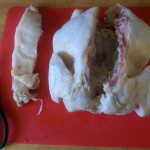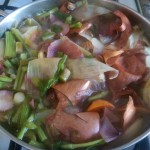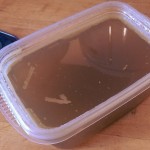Anytime you cook with a vegetable there will be trimmings: roots, tops, skins. Usually these go right in the trash without a second thought. The same goes for bones. What are you going to do with them after you’ve roasted that chicken, pork shoulder or beef shank? You can’t eat them right?
Wrong. Though they may not look like it, veggie scraps and bones are gold. (Maybe not the kind you can take to the bank but certainly the kind you can put in your belly.) Wash vegetables before prepping them and keep gallon bags in the freezer for cuttings. Keep a separate container in the freezer for bones. When you have about a pound of each you have the base for incredible homemade stock. It’s so ridiculously easy to make and so amazingly tasty you’ll kick yourself for all the gold you’ve wasted through out the years. (Well at least you would if you weren’t so busy gobbling it up.)
So what kind of vegetable remnants work best? Traditionally you would use onion, garlic, celery and carrot scraps. But for this preparation I also threw in asparagus, tomato, sweet potato and radish trimmings. Any veggie works as long as you’re open to developing new flavors. As far as bones go, you can use pretty much any type though I like to stick to one protein per preparation. If you want to develop a deeper flavor roast your bones. Just put them in a roasting pan in a 450 degree oven, turning occasionally until they are browned on all sides, about 25 to 30 minutes.You can use your stock for soups and sauces. You can also boil veggies, rice or pasta in it. Really stock’s only limit is your imagination. Let’s get to it!
Tools
- stock pot
- wooden spoon
- fine mesh strainer
- Tupperware to store stock in
Ingredients
- 1 lb veggie trimmings
- 1 lb bones
- 4 quarts cold water
Directions
- Fill your stock pot with your veggie trimmings, cold water and bones. Bring to a simmer but do not boil.
- Simmer your stock for about an hour an a half and remove from the heat. You don’t have to skim your stock. You only want to do that to create a clear broth and that’s not the kind of stock that happens when you throw everything you’ve got in a pot. As far as seasoning is concerned I don’t add salt to my stock, but you are more than welcome to add salt and pepper to taste. It’s your world!
- Once the stock has cooled separate the veggies and bones from your broth using a fine mesh strainer. Place your stock in a Tupperware container, seal and let sit in your refrigerator overnight. All the fat will solidify on top of the stock. You can remove this layer easily before using. BUEN PROVECHO!
Gallery
- Anytime you prep veggies throw the scraps into a gallon bag or Tupperware and freeze them for stock!
- I always spatchcock chicken that I’m going to roast and throw the spine in the freezer for stock.
- I keep chicken bones in the freezer until I get about a pound’s worth. You can roast them if you want, but I just throw everything in as is.
- Throw everything into your stock pot, add water and let it simmer uncovered for 90 minutes.
- Let’s keep it real, this isn’t Michelin star stock, but it is darn tasty and a total breeze to make.








Leave A Comment